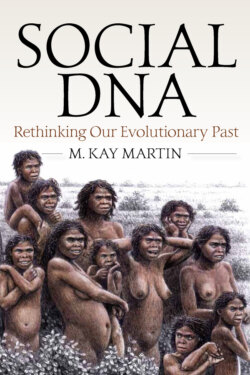Читать книгу Social DNA - M. Kay Martin - Страница 14
На сайте Литреса книга снята с продажи.
Aggress or Coalesce?
ОглавлениеBehind every theory on hominin social origins is an underlying set of biases on what constitutes basic human nature.10 What are the innate propensities that govern intra- and intersexual behaviors, reproductive strategies, social structure, and intergroup relations? As noted earlier, some inclusive fitness models see society as a collection of individuals who engage in cooperative and competitive actions solely in pursuit of their own ends. This portrait of human reproductive behavior congers images of situational loyalties, dominance, subordination, parasitism, deceit, and betrayal. Other origins theories attribute the darker side of human nature to adaptations thought to have accompanied the shift of early hominins from arboreal to terrestrial life. For example, some argue that hunting on the open savanna turned our ancestors into bloodthirsty killer-apes, fierce defenders of territories, and combatants in endemic warfare over mates and scarce resources. A penchant for aggression and violence has also been proposed as an enduring human trait by pointing to these behaviors in contemporary chimpanzees.11
At the other end of the spectrum are theories that suggest that cooperation had greater currency in the evolution of human sociality than competition or aggression. Namely, what separated our ancestors from those of contemporary apes was their liberation from primitive limbic system responses to external stimuli and the attendant modulation of hormonally driven behaviors. Current evidence suggests that cortical expansion and a reorganization of brain function was selected for among early hominins, along with the corollary evolution of behavioral plasticity. The increasing ability to interpret stimuli in light of past experience and to apply reasoned, nuanced responses provided hominins with the necessary social tools for empathic and cooperative behaviors. In short, the success of our ancestral lineages relied on the ability to create win-win rather than win-lose scenarios. As recently noted by Clancy (2017), the emergence of our genus may be more accurately described as “survival of the friendliest.” Survival and reproductive success came to those who learned how to get along and to modify their strategic alliances to meet the challenges of changing environmental conditions. This perspective will be favored here.
While behavioral plasticity greatly expanded the social repertoire of early hominins, it did so without sacrificing the option for outlier responses. Humans are capable of both extreme empathy and extreme violence. Where threats to the welfare of offspring or access to critical resources present themselves, limbic system behaviors may rise to the occasion. Such responses, however, should not be regarded as the essence of human nature, nor as a rationalization for the inevitability of human aggression, warfare, or systems of inequality. What is innate is our ability to gauge responses appropriate to stochastic events. If negative or defensive behaviors have become more frequent in the Holocene and Anthropocene epochs, so too, perhaps, have the environmental conditions that trigger this ancient survival response.
